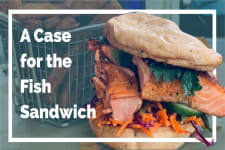Wild-caught king salmon is a large variety of salmon with a big reputation, prized for its rich taste and incredibly delicate texture. Also known as chinook salmon, its unique qualities set it apart from other species of Pacific salmon — some consider it the best salmon to buy when you want to enjoy a very special meal. This species can be prepared using a broad range of cooking methods, including broiling, poaching, baking, searing, or grilling.
King salmon is the state fish of Alaska. While all species of salmon play an important role in Alaskan culture and in a diversity of ecosystems, king salmon stands out due to its sheer size. Chinook also have been known to migrate over vast distances at sea, traveling thousands of miles over the course of their lifetimes to hunt before returning to their natal streams to spawn. All salmon return to their natal streams for spawning, “natal” meaning the streams where they were born.
What does king salmon taste like?
Depending on the season or fishery, king salmon can range from subtle to buttery. Generally, it is delicate in texture and flavorful. Fattier fillets have a distinctively richer taste and a very moist flake. Leaner fillets have a slightly drier texture when cooked, but are still incredibly flaky.
Compared to sockeye salmon, king has a milder flavor and larger, more tender flake. Like coho salmon, it has a subtler taste but can be much richer in fat content. Overall, king has an exquisite appeal that can elevate any meal.
Because king salmon can sometimes have a relatively high fat content compared to other species of wild salmon, it can take a little more time to cook. Leaner cuts are more comparable to coho and sockeye for cook time and cook methods. A nutritional label with fat content can help you understand how long you can estimate for cook time, while an instant-read thermometer can ensure that you’re cooking it to the perfect doneness. 
What does king salmon look like?
King is the largest species of salmon. Compared to other fillets, it can have a pink, orange, or red tone that’s similar to the color of coho. You may be able to notice some light marbling of fat through the fillet, since it can be one of the richer varieties of salmon.
King salmon can also produce white fillets, due to a rare genetic mutation. Some people insist that white fillets are even more delicate in flavor, but the only significant difference between white or pink fillets is the color. They otherwise share the same nutritional profile and cook the same.
Nutrition Facts
King salmon is a lean protein that can be integrated into a wide range of healthy diets. Some cuts contain a higher fat content than others, depending on the season and fishery.
Nutrition per 6-ounce serving:
-
Calories: 180 calories
-
Fat: 5 grams
-
Protein: 34 grams
-
Potassium: 700 milligrams, or 15% RDI
-
Vitamin D: 14.9 micrograms, or 70% RDI
Is king salmon sustainable?
When king salmon is sourced from well-managed wild fisheries in Alaska, it’s a sustainable seafood choice.
King populations are monitored very closely from fishery to fishery to ensure that the industry has specific, up-to-date information on each Alaskan king fishery numbers from season to season. When any fishery’s population falls below a certain threshold, the fishery is closed down to allow numbers to recover to sustainable, healthy levels.
Best Ways to Cook King Salmon
Wild king cooks a bit differently than other species of wild salmon, due to a significantly higher fat content, so you’ll need to make adjustments on cook time.
Where to Buy Wild-Caught King Salmon
Stock your kitchen with sustainably harvested king salmon by sourcing your seafood online from Wild Alaskan Company. You’ll get high-quality, wild-caught seafood delivered straight to your doorstep. Choose your seafood subscription box today.






